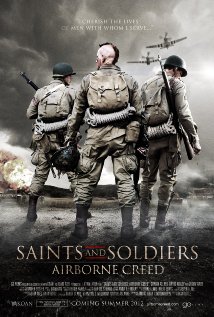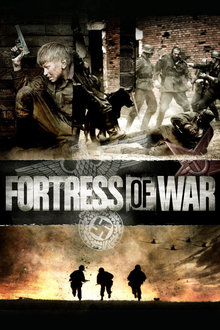I’m a little late on this, but here is my annual post
on the best and worst war movies I reviewed this past year. After five years, I am still seeing some
excellent war films for the first time.
I am also seeing a higher percentage of terrible war movies. Goes with the territory, I guess. Here are the top five war movies I saw last
year:
5. Stalingrad, Dogs Do You Want To Live Forever? - This
is a micro and macro view of the famous battle seen through German
eyes. It is close to being a documentary
as far as teaching about the battle. It
covers the period after the Soviet double envelopment. It gets the rubble and the snow right. It’s a bit clicheish with the good German
versus the bad German and has a bit of an “Attack!” feel to it. There is an interesting romance thrown in
and the combat is excellent. It is the best movie about the Battle of Stalingrad.
4. Theirs Is the Glory - This British war movie is about Operation
Market Garden. It is the grunt level
view as opposed to “A Bridge Too Far”.
It concentrates on the British forces trapped in Arnhem. Many actual British paratroopers act in the
movie giving it a unique realism. The action
is amazing and the movie is admirably accurate.
3. City of Life and Death - This Chinese movie is about the infamous “Rape
of Nanking”. It concentrates on the Chinese
civilians who take refuge in the Safety Zone.
The main Japanese character is a soldier who is a controversially sympathetic
figure. The movie also has roles for
John Rabe and Minnie Vautrin – two foreigner who attempted to save as many
innocent Chinese as possible. It highlights the plight of the “Comfort Women” and the terrible atrocities committed by the Japanese army. There is a nice balance of drama and combat. The cast is excellent and the acting is
stellar. This is a must-see about a must-know-about event in history.
2. "71 -
I was lucky to see this gem in a theater in Austin. Although it got amazing reviews, it did not
break nationwide. It is set in during “The
Troubles” in Northern Ireland. The main
character is a British soldier who gets cut off from his unit in ravaged
Belfast. He spends a night caught
between a corrupt British counterinsurgency unit and two factions of the IRA. The plot has touches of Homer's Odyssey in it. This movie kicks ass in its action scenes and
is full of adrenaline-fueled suspense.
It is full of memorable characters and scenes. This was by far the best war movie that was released last year and the most accessible to an adult male audience.
1. The Brest Fortress (2010)
“The Brest Fortress” (“Fortress of War”) is a Russian
film about the famous defense of Brest Fortress in the opening days of
Operation Barbarossa in WWII. It was
directed by Alexander Kott and had strong input from the Brest Fortress
Museum. The film chronicles the defense
of three separate strongholds within the fortress. The movie was made “in memory of the fortress
heroes”.
The movie is told in flashback form based on the
memories of a then teenage boy named Sasha (Alexey Kaposhov). Sasha and his older brother are orphans who
are in the Soviet Army and stationed at the fortress. Besides the fortress defenders, their
families live within the walls. Life is
normal until the German invasion of the Soviet Union takes the fortress
completely by surprise. The first
inkling that they are at war is when a savage air bombardment pummels the
fortress. Several buildings are blown up
as people run around like chickens with their heads cut off. Soon after, the German army arrives. When the civilians attempt to flee, they are
machine gunned. The siege has begun and
it will not be the cake walk the Germans anticipated.
The movie concentrates on the defense of four
strongpoints and the commanders of each.
Political commissar Fomin (Pavel Derevyanko) is in charge of the Kholm
Gate. Regimental commander Gavrilov
(Alexander Korshuvov) commands at the Eastern Fort and defense of the 9th
Frontier Outpost falls to Lt. Kizhavatov (Andrey Merzlikin). Another force holds out in a barracks. The Germans assault all four positions,
leading to some intense combat. The Germans
use tanks, artillery, and flamethrowers to try to whittle down the
defenders. Through all this Sasha moves
through the maelstrom seeking his girlfriend Anya and taking part in the
fighting. He serves as the framing
device as he connects the isolated forces.
“Brest Fortress” has been on my list of movies to
watch for some time, but I did not assign high priority to it. However, as I am working through the last
stages of my project to determine the 100 Best War Movies, it finally was time
to view it. I have been pleasantly
surprised lately to find that after having reviewed hundreds of war movies,
there are still some outstanding movies I have not seen yet. This is one of those movies.
I was not familiar with the Defense of Brest Fortress
so the movie was not only entertaining, but educational. I suppose every country has its famous ill-fated
siege. Brest Fortress is the Russian
equivalent of the Alamo. Sieges are
grist for war movies because of the potential for cinematic drama. “Brest Fortress” maximizes this by tapping in
to the personal elements of the story.
Not only is there the romance between Sasha and Anya, but there is
another couple that is tragically impacted by the German assault. The fact that families were caught in the
siege adds a dimension that you don’t get in movies like “The Alamo”. There is a strong human dimension to the
film. The decision to concentrates on
the leaders of the strong-points was wise.
Each of these characters is distinctive and compelling. The key to the movie is the Sasha character. His arc is the glue tying together the
various battle sites. His quest to find
his girl friend in the midst of the turmoil brings the audience into the story. It helps that the acting is solid. There is no scene chewing. The dialogue is natural. This is not a propaganda film. The Germans are evil, but it is their
actions, not the soldiers themselves.
There are no German characters in the film to speak of.
Although the movie does a great job personalizing the
siege, the movie is most memorable for its quantity and quality of combat. The opening air bombardment is the best I
have seen. The first fire fight sets the
stage with slo-mo, graphic wounds, hand-to-hand, and extreme action. It reminded me of the Korean style of
movies like “Tae Guk Gi”, but it is also similar to the Russian film "9th Company”. There are several frenetic action scenes. Unlike many war movies, the deaths are not
ridiculously unrealistic. And if you
like explosions, this movie blows things up real good. There is even a two ton kilogram bomb that
results in a humongous explosion. The
German use of flamethrowers is not for the squeamish.
SPOILER ALERT:
The movie does a great job of retelling the Defense of the Brest
Fortress. This was the first encounter
between the Soviets and the German invaders in Operation Barbarossa. The movie clearly depicts the shameful lack
of warning the Soviet defenders got when Stalin had knowledge that the invasion
was coming. The fortress had a garrison
of 9,000 men and 300 families. The air
bombardment was devastating and was followed immediately by assault from 20,000
Germans. The defenders were isolated
into the four positions shown in the film.
THE WORST:
5. Ardennes Fury - This is a mockbuster from the folks at The
Asylum movie studio. It went direct to DVD for obvious reasons. It is set in the Battle of the Bulge. An American tank crew is cut off and has to
deal with an evil German. Very low
budget with sincere, but challenged actors.
Full of clichés and laugh out loud moments. Add a six pack and it is sort of
entertaining.
4. Top Gun -
One of the worst insanely popular war movies ever. “Pearl Harbor” with
unintentional laughs. A movie that was
made to be parodied. A movie where the
best acting is by the F-14 Tomcats. The
movie that brought us the Tailgate Scandal.
The movie that brought us homoerotic male volleyball.
3. Saints and Soldiers: Airborne Creed - The second in the series and a huge
disappointment after the first. American
paratroopers are dropped into Southern France as part of Operation
Dragoon. A few of them are making their
way back to their unit when they hook up with a French Resistance group that
includes a sexy female sniper. There is
a lot of walking and talking in the film.
Everything is below average.
There is no sense of urgency and no suspense. It is very predictable and a waste of time.
2. Fire Fox -
An unbelievable perfect shit storm from the usually reliable Clint
Eastwood. He was in his prime as an
action hero when he directed and starred in this turkey. Clint is a PTSD-plagued Vietnam veteran who
is recruited to go undercover with little training into the Soviet Union to
steal a top secret, next generation fighter plane. The whole plot is beyond preposterous. To top it off, Clint does a poor acting job.
1.
Sky Fighters (2005)
“Sky Fighters” is France’s
answer to “Top Gun”. It was directed by
Gerard Pires. He got cooperation from
the French Air Force including their top gun fighters. The movie opens with the supposed theft of a
Mirage 2000 from an air show. The two
ace / fighter jock / buddy / heroes are recruited for a special anti-terrorist fighter jet
unit. They pair off with two sexy fighter
jockettes. (Spoiler alert: they keep their clothes on.) Eventually they have to deal with Middle
Eastern terrorists who want to blow up a tanker above a European Summit meeting
in Paris. To give you an idea of how
ridiculous the movie is, there is a scene where one of the aces uses a sonic
boom to blow out windows so his captured ami can get loose and he can land and
pick him up. There’s a mole thrown in
for suspense and cliché purposes.
This
movie could not have been worse if it starred Tom Cruise. Speaking of which, the acting is
terrible. The plot is hard to follow
(the opposite of “Top Gun”, but not an improvement). It does have some excellent aerial
photography and some wonderful scenery. The
dogfighting is a plus, but there is only ten minutes of it. Surprisingly, no CGI was used. This does not overcome an overdose of stupid. There is no realism in this film, starting with
the premise that France has some competent pilots.






